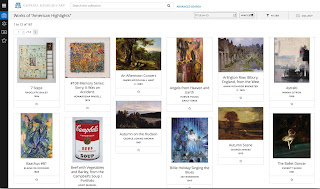Remember the last time you went to the Georgia Museum of Art?
The refreshingly cool foyer? Being greeted by the front desk security guard? You then made your way upstairs and into the galleries to admire the art. How many works of art do you remember seeing? Fifty? One hundred? Two hundred? The museum has about 500 works on display at any given time—only 5 percent of its total collection. The museum is proud that its permanent collection now consists of more than 12,000 works of art from a wide range of cultures and artists, and it does its best to rotate what is on display regularly, but limited gallery space means it can only display a small fraction of what it owns. That’s where the museum’s registrars have been hard at work.
Over the past few years, the registrars have been implementing a new collections database. This new database replaces the old DOS-based database, which was built in the 1980s and only accessible to some museum staff. The new database, called The Museum System (TMS), is online, and information on more than 2,400 works of art is now accessible to the public, with more being added every day. TMS will not only allow the public to explore the full collection, but will also greatly aid scholars and faculty in their research.
Head registrar Tricia Miller is particularly enthusiastic about the public’s access to the new database, saying, “Better access to information about the museum’s collection is one of the Georgia Museum of Art’s primary goals, and we are so pleased to reach this milestone in the process. I look forward to continuing to make more information about the collection available for students, faculty, scholars and the public to enjoy.”
The process of transferring the information from both the old database and from paper files to the new database is intricate. Basic data transferred from the previous system—such as title, date, artist, medium and dimensions—must be reviewed and corrected for each record before it can be made available to the public. In addition, relevant metadata, such as subject, country of origin or style of art will be added to the records in order to enhance the system’s search capabilities. The process may take several more years before all 12,000 records are made public, but the registrars work every day to make more records available. Additionally, all newly acquired objects will be added to the system on an ongoing basis.
Not everything in the system has a photograph attached to it. The registrars have been taking snapshots of new objects when they enter the collection for some years, but many works that were acquired earlier have not been imaged. It is the registrars’ hope to find funding to document the entire collection photographically at some point.
The public can access TMS through the collections page on the museum’s website (georgiamuseum.org), which presents several options. You may view collections of highlighted works (African, American, European, Asian and decorative arts for now). You may view the works by category (print, painting, drawing, photograph, etc.). You may view all works alphabetically, by date or by object number, if you just want to browse. You can also search a word—for example, “bird,” which will return works relating to birds. These specifications are what make this new database so efficient, cutting out the need to spend hours going through files to find exactly what you may be looking for.
Another revolutionary function of TMS is that it allows visitors to sign in and create a folder of their favorite images, called “My Collection.” This feature allows people to play curator, creating their own online “exhibition” and forging a personal connection to the collection. These collections can be kept private or made public to share with other users on the site.
So the next time you find yourself mindlessly surfing the Internet, take a minute to examine the new database. You may find a work that inspires you, examine the career of a local artist or bask in the glory of a master of American impressionism. You never know what you’ll find.
Stephanie Motter
Intern, Department of Communications


No comments:
Post a Comment